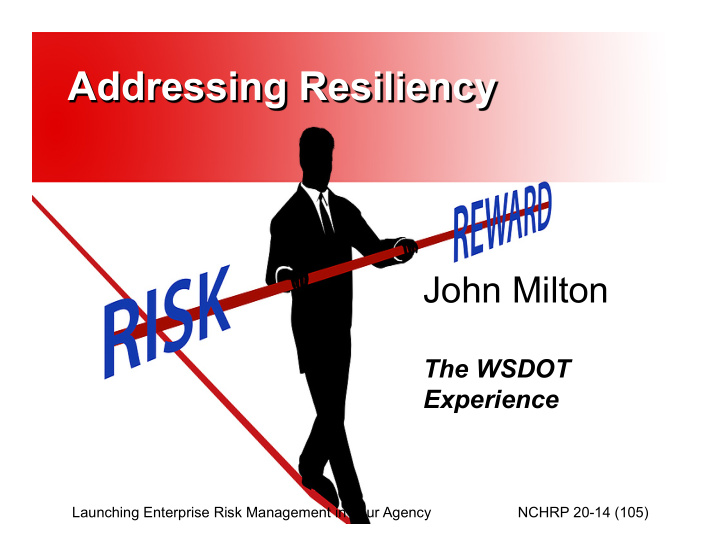



Addressing Resiliency John Milton The WSDOT Experience Launching Enterprise Risk Management in Your Agency NCHRP 20-14 (105)
Res esilienc iliency in in a a changing hanging en envir ironment onment Cons onsider idering ing ris isk k to o WS WSDOT Asset ets Lynn Peterson AASHTO Enterprise Risk Management Workshop and John Milton, Ph.D. PE Peer Exchange Director - Quality Assurance and Secretary of Transportation Transportation System Safety August 24, 2015 Washington State Department of Minneapolis, Minnesota Transportation 2
Preparing a plan of action for Washington
Goal: Preserve assets in a changing environment • Apply an asset management approach – Be ready for severe weather events and long-term changes in site conditions – Inform long-term decisions – Build resilience where possible • Conduct a statewide vulnerability assessment – Test-drive the FHWA model – Understand and communicate current science – Scope: Consider impacts on our all WSDOT assets Highways, Ferries, State-owned Rail and Airports 6
Changes ¡in ¡Flood ¡Risks ¡ • Floods ¡in ¡western ¡Washington ¡will ¡likely ¡increase ¡in ¡ magnitude ¡due ¡to ¡the ¡combined ¡effects ¡of ¡ warming ¡and ¡increasingly ¡intense ¡winter ¡storms. ¡ • In ¡other ¡parts ¡of ¡the ¡State, ¡changes ¡in ¡flooding ¡are ¡ mixed, ¡and ¡in ¡eastern ¡Washington ¡projected ¡ reduc&ons ¡in ¡spring ¡flood ¡risk ¡are ¡common ¡due ¡to ¡ loss ¡of ¡spring ¡snow ¡cover. ¡ Mixed Rain/Snow Rain Dominant Chehalis River (Western WA) Yakima River (Eastern WA) 7 7 Mantua et al. 2009, Elsner et al. 2009
FHWA risk assessment model 8
Step 1 – How critical is the asset? WSDOT Methodology
Step 2: What are the Climate Threats? • Began with climate change forecast from UW Climate Impacts Group • Talked about observed changes and extreme events – what is happening now • WSDOT’s internal experts ranked all WSDOT assets • Key Questions: • “What keeps you up at night?” • “What if it gets worse (given the scenario)?” • “How resilient is our existing system? 10
We used our experience to gauge future impacts Jim Park, WSDOT 11
Workshops: How might climate impact assets? Primary Can lead to impacts on... climate drivers Expansion joints, pavement, rail tracks, construction periods, habitat projects, Temperature electrical equipment Flooding of surface roads & tunnels, road washout, Precipitation pump capacity, drainage Soil instability, water supply, bridge and road support Hydrologic shifts structures Sea level rise, Coastal erosion, coastal and upriver flooding, bridge storm surge footings, drainage, roadside stability, salt / corrosion
1 2 3 4 5 6 7 8 9 10 Complete catastrophic failure Results in total loss or ruin of asset. Asset may be available for limited use after at least 60 days and would require major repair or rebuild over extended period of time. “Complete and/or catastrophic failure” typically involves: • Immediate road closure; Record impact score • Disruptions to travel; • Vehicles forced to re-route to other roads; • Reduced commerce in affected areas; • Reduces or eliminate.es access to some destinations; • May sever some utilities located within right-of-way; • May damage drainage conveyance or storage systems. Temporary operational failure Results in minor damage and/or disruption to asset. Asset would be available with either full or limited use within 60 days and may have immediate limited use still available. “Temporary Operational Failure” typically involves: • Temporary road closure, hours to weeks; • Reduced access to destinations served by the asset; • Stranded vehicles; • Possible temporary utility failures. Reduced capacity Results in little or negligible impact to asset. Asset would be available with full use within 10 days and has immediate limited use still available. “Reduced capacity” typically involves: • Less convenient travel; • Occasional/ brief lane closures, but roads remain open; • A few vehicles may move to alternate routes; Figure 2.1 Photo depictions of qualitatively assessed climate change consequences
What did we find? • Intensifies known threats • Reinforces value of our current maintenance and retrofit programs • Some surprises • Unique way to capture knowledge of field staff
NW Region Area 3 Sample Location: I-5 mp 192.6 to 201; Snohomish River basin to Quilceda Creek. (in red) Impact Score (Precip/SLR 2’,4’,6’): 8, 10, 10 NOTES: Low elevation. River delta, lots of diking districts. Tidal influence with Union and Steamboat sloughs. Saturation of embankment. If dikes rupture, would be major impact. Roadbed is good, but bridge column would be issue. Scour critical bridges here. I-5 Snohomish bridges are good deep piers. Aggradation is occurring here.
We want to illustrate current practices that are effective adaptation strategies From disaster to resiliency Drilled shaft bridges like this one on I-90 near Gold Creek make those structures more resistant to high- velocity flooding.
Where are we today and what are we saying? Key talking points we are using: • Responsible asset management: Not a new program • Our big capital projects incorporated this info • We don’t want to be caught off guard, but we don’t want to OVER-design either.” – Rick Keniston (5/1/12 Columbian) • 50 years from now, we want people to say: “I’m so glad they thought about this!”
Recommend
More recommend